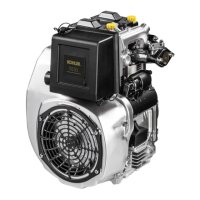- 19 -
2
8 50 200 300 400 2500 5000
(*)
(*)
(**)
(**)(***)
(x)
(xx)
Technical information
OPERATION OPERATION DESCRIPTION
Frequency x hours
Cleaning
Oil-bath air cleaner
Head and cylinder ns
Internal oil lter
Fuel tank
Injectror
Check
Level air cleaner oil
Level oil sump
Battery uid
Valve/rocker arm clearance
Injector setting
Replacement
Oil air cleaner
Oil sump
Internal oil lter cartridge
External oil lter cartridge
Fuel lter cartridge
Dry air cleaner cartridge
Overall
inspection
Partial
Complete
ROUTINE ENGINE MAINTENANCE
Important
• Failure to carry out the operations described in the table may lead to technical damage to the machine and/or system
First replacement
(*) Under severe working conditions, clean daily.
(**) Under extremely dusty conditions, change every 4-5 hours.
(***) See recommended oil type.
(x) The partial overhaul includes the following operations: valve and seat lapping, injector and injection pump overhaul,
injector projection check, fuel injection spark advance check, check of the harmful area between head and piston,
camshaft and crankshaft end oat check, tightening of bolts.
(xx) The general overhaul includes - in addition to all partial overhaul - the following procedures: cylinder and piston
replacement, seat, guide and valve refacing, crankshaft replacement or grinding, bench bearing and connecting rod
replacement.
Danger
• To avoid explosions or fire outbreaks, do not smoke or use naked flames during the operations.
• Fuel vapours are highly toxic. Only carry out the operations outdoors or in a well ventilated place.
• Keep your face well away from the plug to prevent harmful vapours from being inhaled. Dispose of fuel in the correct way and
do not litter as it is highly polluting.
FUEL
When refuelling, it is advisable to use a funnel to prevent fuel from spilling out. The fuel should also be ltered to prevent dust or
dirt from entering the tank.
Use the same type of diesel fuel as used in cars. Use of other types of fuel could damage the engine. The cetane rating of the
fuel must be higher than 45 to prevent difcult starting. Do not use dirty diesel fuel or mixtures of diesel fuel and water since this
would cause serious engine faults.
The capacity of the standard tank is: lt. 4,0
The maintenance operations listed above refer to an engine operating in normal conditions (temperature, degree of humidity,
dust in the working environment). They may vary signicantly according to the type of use.

